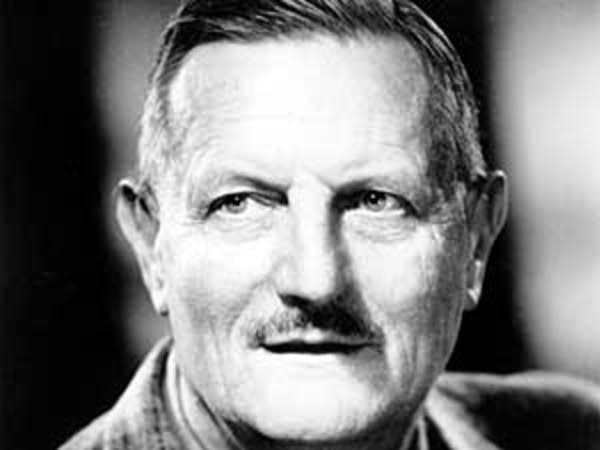Guthrie and Rapson battle again
Go Deeper.
Create an account or log in to save stories.
Like this?
Thanks for liking this story! We have added it to a list of your favorite stories.

Playwright Jeffrey Hatcher says whether it's remodeling a kitchen or creating an iconic theater, there is a special relationship between an architect and a client.
"It's not quite the same as psychiatrist, or dentist, or surgeon," Hatcher laughed. "But it's close, because you are going to create something, and it's got to please the artist, and it's got to please the client. And in a case like this, it has to please an audience so much you have to build an entire theater movement out of it."

Tyrone Guthrie and Ralph Rapson came from very different worlds.
Guthrie was a patrician Irishman who had earned his place in the cultural elite through his directing work in London and New York. He came to Minneapolis to establish great theater outside New York, and he was used to getting his way.
Turn Up Your Support
MPR News helps you turn down the noise and build shared understanding. Turn up your support for this public resource and keep trusted journalism accessible to all.
Rapson was building an international reputation for his sleek modernist designs. Rapson was very much a Midwesterner -- polite, but with lots of ideas and very strong views.
The project's funders selected Rapson without consulting Guthrie.
In the play the disputes begin early between Rapson, played by Mark Benninghofen, and Guthrie, portrayed by Steve Hendrickson.

"Dr Guthrie, what sort of theater do you want?" Rapson asks.
"Well, what sort of theater do you think it should be?" Guthrie replies.
"There are four possibilities," says Rapson. "Proscenium, thrust, in the round and flexible."
"Ralph, descant, if you will, on the flexible," Guthrie purrs.
"Well, the flexible has certain advantages."
"Such as?"
"It's flexible."
"So if you had to choose at this moment, is that what you would design?" asks Guthrie. When Rapson begins to look for a way out of the conversational trap, Guthrie snaps, "Imagine I'm putting a gun to your head."

"Oh, I don't have to imagine," Rapson says.
Jeffrey Hatcher says while the arguments are about the design of the building, the story is about two men who are both in crisis. Guthrie's career was on the slide.
"People really mocked him for coming to Minnesota. They said, 'Of course they will think you are great, it's Minnesota. You just can't fight it out with the rest of us here in Broadway and London,'" said Hatcher. "And a guy like Ralph, who has a perfectly good career but he hasn't made the big thing that's going to make everybody sit up and take notice."
They fought over the thrust stage which Guthrie wanted and the asymmetrical design wanted by Rapson. And then there was the question of the seats.

"Why are they so many different colors?" demands Guthrie. "They look like the interior of a Baltimore whorehouse."
"No, they are meant to suggest brightness and vivacity," replies Rapson.
"Well, I say they suggest lollipops and socialism. They can grace the men's room of a Scandinavian airport lounge, but I will not have them in my theater," says Guthrie, his voice rising.
"I'm trying to suggest fun!" retorts Rapson.
Guthrie is incredulous.
"This is the theater, Ralph. We are not putting on a puppet show for Romanian television!"

Guthrie ordered Rapson to make sure the seats were all the same bland color. Rapson disobeyed. By the time the hundreds of multicolored seats arrived, it was too late for Guthrie to do anything about it.
"Tyrone and Ralph" gets its world premier Saturday at the History Theatre. It will run through early November.
Pioneer Press theater critic Dominic Papatola says Jeffrey Hatcher's talents are particularly suited for this piece.
"He is a quick study," said Papatola. "We know he is a master of dialog. We know he has a vicious, wicked sense of humor, and these are all things which we know will serve him well in this play."
There was some discussion with the Guthrie Theater about performing "Tyrone and Ralph" at the new Guthrie, but History Theatre Artistic Director Ron Peluso says things didn't work out. However, he says the play will be performed in a Rapson theater -- the History Theatre itself.

"This theater was built in 1963-'64 as the Guthrie was being constructed over there, and Ralph was the head architect," Peluso said. "He designed kind of a miniature Guthrie. It's 600 seats. (It) doesn't have the alpine slope, or anything, all the bells and whistles of the Guthrie, but it's a beautiful intimate theater."
A lot of research went into "Tyrone and Ralph," although Hatcher says he invented many of the scenes. He showed a draft to Ralph Rapson, and says the architect objected to very little.
"The only things that Ralph felt uncomfortable about was anything that made him seem too much the yokel next to the great man," Hatcher said. "And I think in the rewrites Ralph would have been pleased that Ralph has a lot more material. Ralph is a lot more dynamic, and he pushes back more. I just wish had lived to see it that's all."
Ralph Rapson died in March of this year.
His theater has been demolished, although many of his design ideas appear in the new Guthrie complex.




